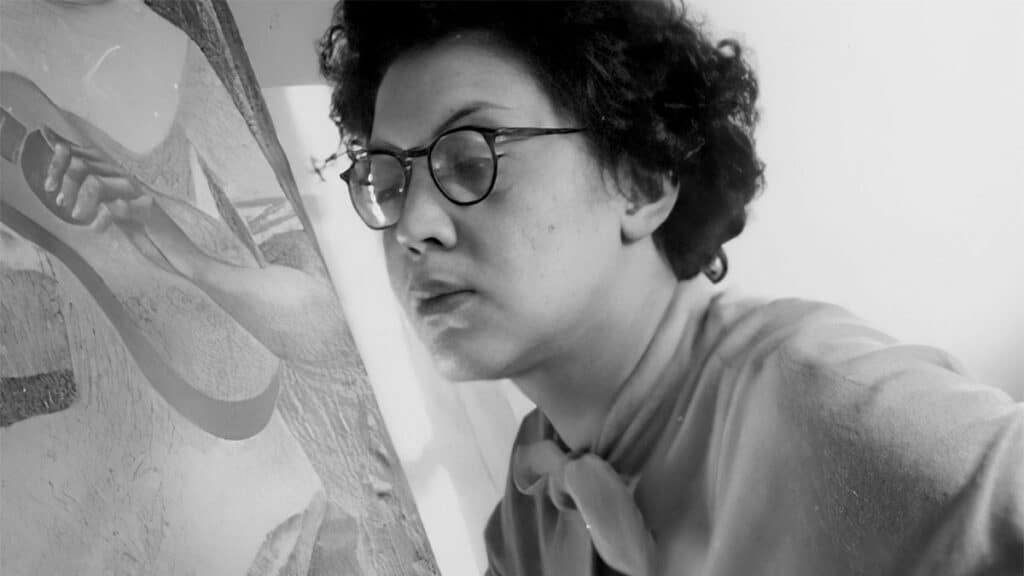
In the broadest frame, Elizabeth Catlett is a brilliant African American woman artist and educator of Washington D.C. and the Harlem Renaissance, who first raised her artistic voice in the 1940s, moved to Mexico to study the Mexican muralists, and stayed. There she found her stride in the renowned Taller de Gráfica Popular (People’s Graphic Workshop), learned ancient Indigenous sculpture techniques, and became a Mexican mother and educator. Her Black Revolutionary perspective and the embrace of Mexican social movements made her an outcast in her own country. She just kept creating, teaching, and growing. Eventually the United States and others who once rejected her, embraced her. Catlett’s voice evolved through the years, but the common thread through it all is dignity.
Her iconic sculpture “Black Unity” (1968) is a closed fist on one side, and a pair of African Diasporic faces, female and male, on the other. Many see the raised fist as a call for violent struggle, but it isn’t. The raised fist is a call for the unity which is essential for communities to thrive. And in communities of color, our concept of unity includes everyone.
#ElizabethCatlettBkM
Elizabeth Catlett a Black Revolutionary Artist and All That It Implies
Elizabeth Catlett: A Black Revolutionary Artist and All That It Implies, an engaging retrospective about one of the defining Black woman (and Mexican) artists of the 20th century; is in the Elizabeth A. Sackler Center for Feminist Art at the Brooklyn Museum in Prospect Heights, Brooklyn; from September 13, 2024 to January 19, 2025. brooklynmuseum.org 🇺🇸 🇲🇽
Catlett was denied entry into the United States for a speech in the 1970s, as a threat to the well-being of the United States of America. So she delivered her keynote address to the Conference on the Functional Aspects of Black Art (CONFABA) by telephone and said, “For I have been, and am currently, and always hope to be a Black Revolutionary Artist, and all that it implies!” That’s where the title of this exhibition comes from.
For I have been, and am currently, and always hope to be a Black Revolutionary Artist, and all that it implies!”
Elizabeth Catlett
Elizabeth Catlett

Elizabeth Catlett is well known in the art world, especially among artists of color who study her representation of people of color. But she isn’t well known among the general public. She did most of her work in a time when it was much harder for women, people of color, and emigrants to gain recognition. That’s why she became an educator. Her renaissance is part of the art world’s recent recognition that great art wasn’t only made by European men. It was made by women and people of color around the world, and across time.
Catlett is known as an African American artist who worked in Mexico, but her practice really is a product of both cultures. You can call her African, you can call her American, you can call her Mexican. All are correct, yet she transcended labels with her humanity.
She lived almost 100 years through times of great social change. Elizabeth Catlett was a highly-educated and very engaged artist who like a real-life Forrest Gump, kept finding herself at important moments in American history. Her life is a great story. (Brooklyn filmmakers, Bed-Stuy + Sunset Park, take the hint.)
Some of the art is hard to stomach because of our violent American history. But it is important to bear witness. We can’t move forward together without accepting the past, and our American past is both noble and shameful. It still affects our present. Much of Catlett’s work in Mexico on Black Women in the 1940s shows that vacant, hopeless stare. It’s what you see in people whose lives don’t offer much hope. In her 1950s work, you still see pain, but it is balanced with determination. Her 1970s work is full of the pride and fight of the Black Arts Movement which continues to color the art of today. Catlett’s later work is heroic, as if she brought Mexican murals to life.
She didn’t just make art, she wrote papers, gave talks, protested, and taught. She was the real thing, an artist’s artist. In a way, Catlett’s art is just a small part of her influence. She is one of those people who make you wonder how they accomplished so much in one lifetime.
Few artists are so eloquent in both figurative and abstract forms. The African influence on her abstractions is wonderful. Her fusion of American, African, and Mexican influences is striking. None of it sits still. When you look at the art, you actually feel it. The work is so emotive, it is almost aromatic. The memory of it will follow you around for days. The common thread through all of Elizabeth Catlett’s work is dignity, the dignity of a woman of color in all her glory.
My right is a future of equality with other Americans”
Elizabeth Catlett
Catlett proved herself more than the equal of anyone, and raised a standard that we can all get behind today. And now is the time. New York City is in the early stages of the Harlem Renaissance 3.0, the next stage after the Black Arts Movement of the 1960s-1970s.
One of the marvelous things about Catlett is that in her old age, she looked Mexican. You wouldn’t now she was African American, unless someone told you. Most Mexicans and many Latins have a “Black Grandmother in the closet” (Henry Louis Gates, Jr.). Many of us are taught from birth to deny our heritage, but now we can be proud of all of it. We are cut from the same cloth, and like Elizabeth Catlett, we are no longer the invisible people. That is revolutionary.
Information
Stop in the museum store on the way out and get the exhibition catalog edited by Dalila Scruggs, if you can. It’s excellent. There are many nights of inspiration on those pages.
